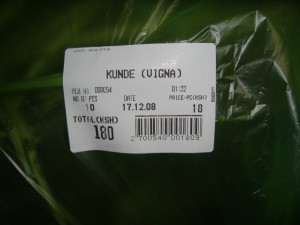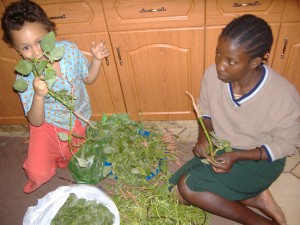- Cajun squirrel crisps, anyone? Jeremy comments: “Burgoo that for a laugh”.
- An Office of Ecosystem Services and Markets? In the USDA? Pinch me!
- “In 2009 my plan is to grow a lot of things, like millet, groundnuts and sorghum, but my energy is waning.”
- “Noah’s Bin, will be the fourth largest of its kind in the world.” In Turkey, apparently.
Videos on traditional food systems
The Centre for Indigenous Peoples’ Nutrition and Environment (CINE) based in McGill University, Canada, responded to requests from indigenous leaders from around the world to help stop loss of traditional food system knowledge with research and community-driven activities that bridge the generation.
This series of videos presents highlights from 12 indigenous community areas in 9 countries, and is intended to con tribute to the evidence base used to make global policies to protect Indigenous Peoples’ food resources and promote good health.
Thanks to Lois Englberger for the tip.
Traditional African vegetables hit the mainstream
It’s not really all that long since we brought together researchers on that overlooked portion of African agrobiodiversity that is its traditional vegetables for one of the first ever times. I wonder how many of us ever thought that in little more that 10 years we would be able to buy terere and managu and the like wrapped in plastic and barcoded in supermarkets in Kenya:

Or indeed buy nicely packaged and labelled seed from small agricultural suppliers in places like Limuru:

Preparation is time-consuming and fiddly, sure:

But the taste and nutrients are worth it, as more and more people are finding out. We had some Amaranthus for Christmas lunch, from grandma’s shamba. Can’t get much more mainstream than that.
Eating Fluffy
Check out this longish meditation on Peru’s main source of protein. Recipe included. Delicious!
And while we’re on the subject of protein on the hoof, as it were, the BBC has a great series of photos of the season of cattle crossings along the River Niger in Mali.
Nibbles: Journal, Biofuel source, Old seeds, Bees, Aquaculture, Millennium Seed Bank, Pests, Earthworms, Jellyfish, Cuba, Japan, Kerala, Queensland, Goats, Cacao, Savanna, Global maps, Nepal
- New Gene Conservation is out. Put out more flags.
- Biofuel from coffee grounds? Right. Hope the stuff was shade-grown, anyway.
- Is a lupin or date palm seed the oldest ever found? Let the controversy rage.
- Bees scare caterpillars as well as pollinating plants. Thankfully, Europe is on the job, colony-collapse-wise.
- Trouble for Scottish farmed salmon. And the wild ones may have their problems too. But aquaculture in general is booming, they say.
- Google Earth discovers forest. Not agrobiodiversity, but fun nonetheless.
- “It doesn’t just take in seeds – it sends them out.”
- Maize pest will love climate change. Well, some of them anyway.
- The latest review of earthworms discussed.
- Jellyfish and chips?
- Eating local pretty much unavoidable in Cuba. Yes, everyone wants to be a locavore these days.
- Japanese amateur botanists get into genebanking.
- “108 dishes based on jackfruit and seed varieties that are facing extinction were also exhibited at the festival.” 108?
- Queensland markets its tropical produce via a new website. No reason why others shouldn’t do the same, is there?
- “People shouldn’t underestimate how important a goat can be for a family in Africa.” Having had to assist in slaughtering one over Christmas, I certainly don’t.
- A rapid run-through the history of chocolate.
- Long-fallow agriculture in Mali leads to more, more diverse and taller trees.
- Global accessibility map published. Also one of fires, and intact forests. Let a thousand agrobiodiversity mash-ups bloom. Thanks, Andy.
- Nepal has lots of medicinal plants. Funny they don’t seem to feature in the Western Terai Landscape Complex Project.